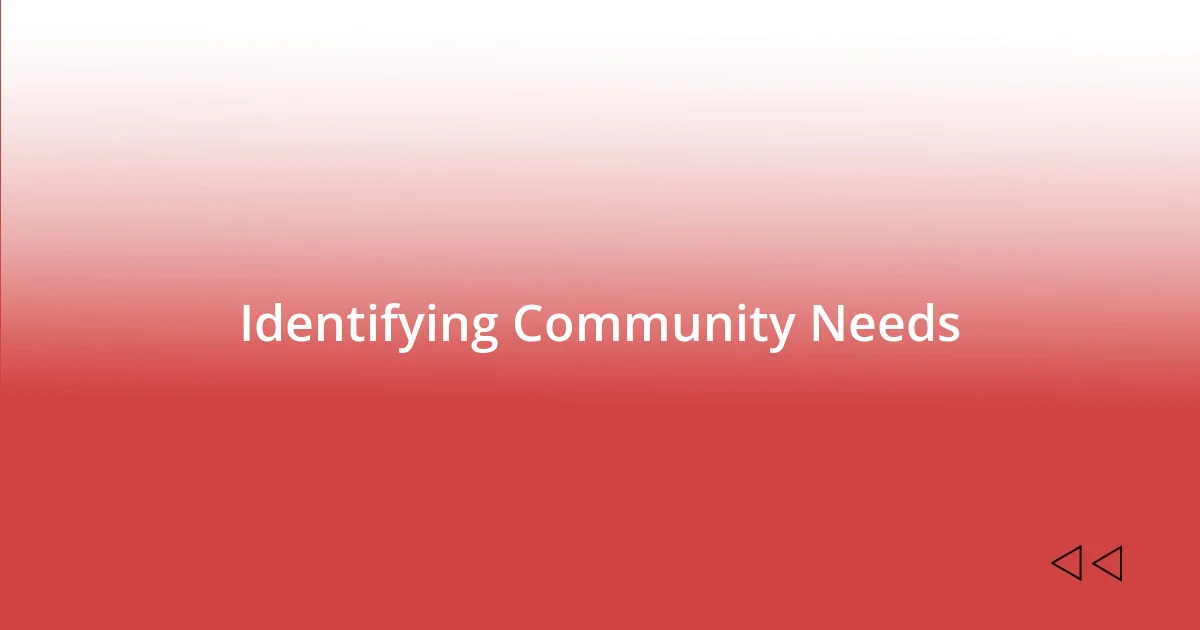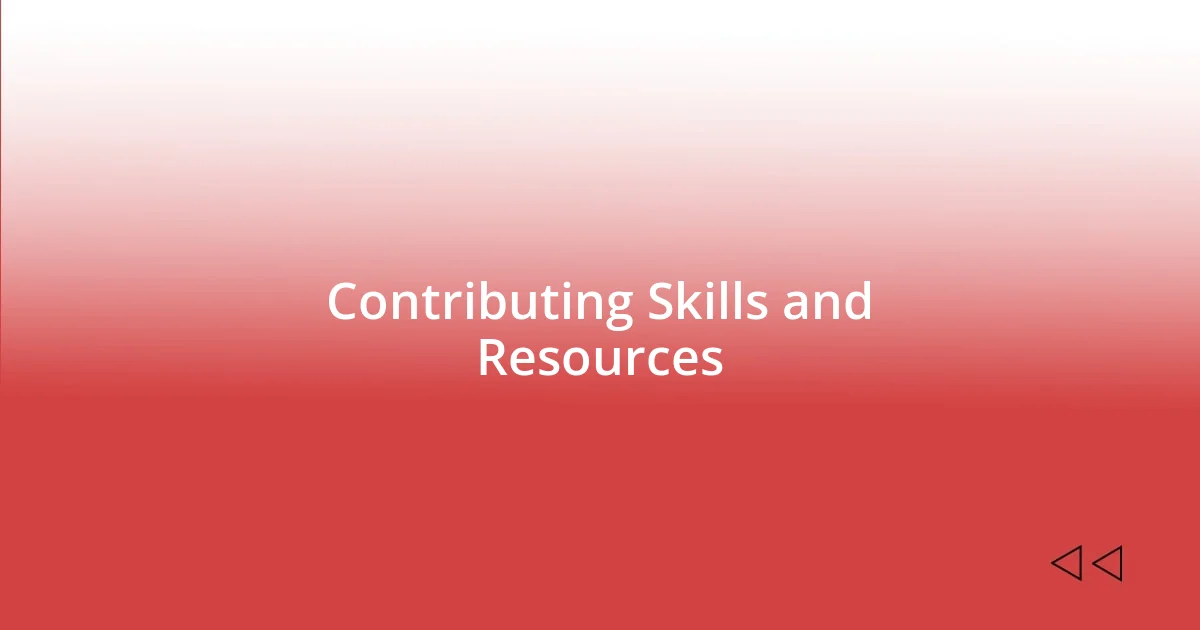Key takeaways:
- Community engagement fosters genuine connections and trust, showcasing the importance of collaboration for collective well-being.
- Identifying community needs through conversation, surveys, and observation empowers residents to express their desires and challenges, leading to actionable improvements.
- Sharing personal experiences and stories enhances relationships within the community, empowering others and fostering a culture of mutual support and growth.

Understanding Community Engagement
Community engagement is about fostering connections between individuals and their neighborhoods. I vividly remember a local clean-up event I attended, where strangers became friends over a shared purpose. It made me wonder: how often do we truly take the time to connect with those around us?
At its core, community engagement is rooted in trust and collaboration. I once helped organize a community potluck that turned into a heartwarming exchange of stories and cultures. It was eye-opening to realize how food, something so universal, can bridge gaps and create lasting bonds among residents.
This practice goes beyond mere participation; it’s about genuine investment in the collective well-being. Reflecting on my own journey, I’ve often asked myself how my efforts contribute to a larger vision. Engaging with community projects doesn’t just build neighborhoods; it shapes our shared identity and empowers us all.

Identifying Community Needs
Identifying community needs can often feel like piecing together a puzzle. In my experience, one of the best ways to uncover these needs is simply to start conversations. For instance, I remember attending a town hall meeting where residents shared their struggles with shared resources. Listening to their stories not only illuminated specific challenges but also helped identify potential areas for improvement.
Another effective method I’ve found is conducting surveys. When I assisted a local group in creating a questionnaire, it was rewarding to see how residents opened up about their experiences and desires. A simple question like, “What would make your community better?” sparked responses that highlighted everything from better parks to more accessible health services. The insights gained were invaluable, showcasing the power of direct engagement in understanding community dynamics.
Sometimes, it’s about being observant, too. I often walk through my neighborhood, absorbing the vibe—what facilities seem neglected, or where people gather. One day, I noticed that the local playground was empty and in disrepair, which led me to realize that families might be longing for safe, engaging spaces for their children. Recognizing these unspoken needs can inspire actionable projects that resonate with the community.
| Method | Example |
|---|---|
| Conversations | Town hall meeting discussions revealing challenges |
| Surveys | Questionnaires gathering resident feedback |
| Observation | Noticing an empty, neglected playground |

Finding Local Projects to Join
Finding local projects to join can indeed be a fulfilling endeavor, but knowing where to look can sometimes be the trickiest part. I recall my excitement when I stumbled upon a community bulletin board at my local coffee shop. It was brimming with flyers showcasing various initiatives, from gardening clubs to literacy programs. I felt a spark of inspiration just seeing so many opportunities waiting for engagement.
Here are some effective places to explore for local projects:
- Community Centers: Often serve as hubs for programming, which may include volunteer opportunities.
- Social Media Groups: Platforms like Facebook or Nextdoor can be treasure troves for local events and projects needing support.
- Local Libraries: Frequently host programs and can connect you with community needs through events and workshops.
- Schools and Universities: Reach out to local educational institutions for service-learning projects; they often involve community outreach.
- Nonprofit Organizations: Many have websites that list volunteer opportunities and upcoming events.
Connecting with these resources might just lead you to your next impactful adventure. One Saturday morning, I took a stroll through the local farmers’ market and found a booth dedicated to a habitat restoration project. I was captivated by their passion and immediately volunteered. That spontaneous decision led to some of the most enriching connections I’ve made in my community. Engaging with local projects not only strengthens your neighborhood but also brings a sense of fulfillment I believe everyone should experience.

Building Relationships with Stakeholders
Building strong relationships with stakeholders is foundational for successful community projects. In my own experience, I found that earning trust begins with authenticity. I recall meeting a local business owner while coordinating a neighborhood clean-up. I approached him with genuine curiosity about his thoughts on community involvement, leading to an unexpected collaboration. It reminded me that when stakeholders see you value their input, they become much more invested in the success of the project.
Another aspect I’ve learned is the importance of regular communication. I make it a point to check in with stakeholders not just during meetings but in casual settings too. For instance, I once bumped into a city council member at a local event and casually shared updates on our project. That brief conversation solidified our partnership and reinforced a sense of teamwork. It’s like planting seeds; the more you nurture those connections, the more they grow and flourish.
I’ve also discovered that acknowledging the unique strengths of each stakeholder can be incredibly empowering. One time, I collaborated with a neighborhood artist who brought a vibrant perspective to our public art project. Recognizing her talent and encouraging her to lead the design transformed our community mural into a collective masterpiece. Have you ever considered how much richer an initiative becomes when everyone plays to their strengths? I believe that fostering this kind of inclusive environment not only enhances cooperation but also builds a lasting sense of community ownership.

Contributing Skills and Resources
When it comes to contributing skills and resources, I’ve often found that the key is to align personal strengths with community needs. For example, I have a background in graphic design, so when I volunteered for a local nonprofit, I offered to help create promotional materials for their events. Seeing my designs come to life in the community was incredibly satisfying, but even more rewarding was witnessing how effective they were in drawing people in. Have you ever thought about what unique skills you bring to the table, and how they could enhance a project?
One memory that stands out involves a community garden initiative. I had some gardening experience, and I eagerly shared tips on sustainable practices with fellow volunteers. It wasn’t just about planting seeds in the ground; it was also about sharing knowledge and fostering a sense of shared responsibility. Participating in that project made me realize how vital it is to equip others with skills that empower them. Each workshop we held not only beautified our space but also helped individuals boost their confidence in gardening.
It’s important to remember that contributing resources doesn’t always mean monetary donations. I once organized a local supply drive, encouraging my neighbors to donate gardening tools and seeds for a community project. The outpouring of support was heartwarming, and it brought a sense of collective ownership to the initiative. This experience made me wonder—what hidden resources might your community have, waiting to be unlocked through simple acts of collaboration? The spirit of giving, in all its forms, can turn a good project into something truly transformative.

Evaluating Impact of Participation
Evaluating the impact of participation in community projects can be quite revealing. I remember during a literacy initiative, we surveyed participants before and after the program. The change was striking; not only had reading levels improved, but participants expressed newfound confidence. Have you ever felt that jump from uncertainty to empowerment? It’s a profound transformation that emphasizes the value of our efforts.
As I reflect on these evaluations, they often provide insights that extend beyond numbers. In one project, we implemented a feedback loop where participants shared their experiences. The stories—stories of struggle turned into success—painted a fuller picture of our impact than any statistic could. This made me realize that qualitative data, like personal narratives, can often resonate more than quantifiable results. How often do we overlook the power of a simple story in understanding progress?
Moreover, the community’s response to our initiatives profoundly shaped future projects. After gathering feedback from participants about what worked and what didn’t, I was pleasantly surprised to see them take ownership of ideas for improvement. It’s empowering to witness a cycle of engagement, where participants transform from beneficiaries into contributors. Isn’t it amazing how engagement evolves? Our goal should always be to cultivate spaces where everyone feels their voice matters.

Sharing Experiences and Lessons Learned
When I think about sharing experiences and lessons learned from community projects, one instance comes to mind that really shaped my perspective. During a mentorship program, I paired up with a young artist who struggled with self-doubt. As I shared my own journey of setbacks and triumphs, I could see her confidence blossom. Isn’t it fascinating how vulnerability can create a bridge between people? By simply being honest about my own challenges, I helped foster a safe space for her to express herself.
Another lesson I’ve gathered is the importance of storytelling in connecting with others. I once led a workshop where participants shared their personal stories about overcoming obstacles. The room was filled with laughter and tears, and in that moment, we didn’t just learn from each other; we became a community. It struck me how these shared narratives can break down barriers and create camaraderie. Have you ever experienced that magical moment when a story resonates so deeply that it unites people?
With each community project I engage in, I strive to reflect on what worked and what didn’t, turning those reflections into actionable insights. After a local cleanup drive, for example, I encouraged my teammates to share their thoughts in a casual debrief. One volunteer mentioned they found purpose in the simple act of picking up trash, which opened my eyes to the value of those seemingly small contributions. This got me pondering: how often do we overlook the significance of individual efforts in the grand scheme? It’s these moments of sharing that reinforce my belief that every experience, good or bad, carries lessons that deserve to be celebrated.















